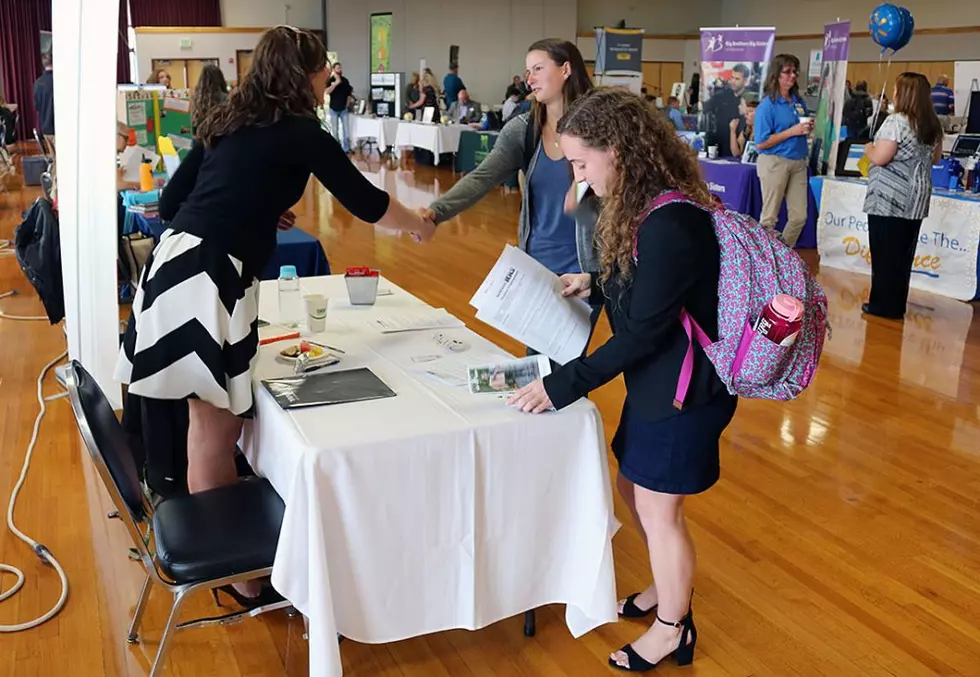
Extra cash or a necessity, UM students seek work at annual job fair as semester begins
Dozens of employers from Missoula and beyond set up shop at the University of Montana on Thursday, most looking for students looking for work.
Some sought a job to stay busy after class. Others described that elusive position as a necessity to make ends meet and pay the bills.
“I don't need a job, but I'd like to have a little extra spending money,” said Taylor Fairman, a freshman from Lake Tahoe, Nevada. “I'm looking for experience, but with the field I'm in, it's really hard to get experience at my age. So I'm just looking to get my foot in the door with something like campus recreation and build up from there.”
Thursday's event marked the dwindling hours of Welcome Week, one where the university rolls out the red carpet for students as they return to campus and buckle down for fall semester.
The job fair attracted a wide range of employers, most of them from Missoula.
“Our patient safety sitter is the job we're featuring today, and it's super flexible scheduling,” said Paige Lewis, the recruitment coordinator for Community Medical Center. “It's a chance for them to get all over the hospital so they're not confined to just one space. It's really great for pre-nursing to get some hospital experience.”
The hospital also offered job training in phlebotomy. Both positions paid more than minimum wage, according to Lynette Trowbridge, the hospital's human resource specialist.
“We do have students from the university on staff right now, and they seem to be our better candidates, which is why we came here today,” said Trowbridge. “The positions are very flexible, so they can work around their class schedule and study habits.”
A new report released by the Georgetown University Center on Education and the Workforce found that most students can no longer pay for college through part-time work, as they could a generation ago.
And as students take on extra hours of work, their grades tend to drop and the years they spend in school grow longer, adding to the cost of college, the report suggested.
But work has also become a necessity for most students, given the cost of higher education. Between 2005 and 2016, prices for undergraduate tuition, fees, and room and board rose 34 percent for public colleges, according to the National Center for Education Statistics.
Paying student loans, rent and those monthly necessities requires some students to earn an income while in school.
“I'm just looking for a part-time job to help me get through,” said Mary Casey, a first-year graduate student from New Hampshire who will major in anthropology. “I'm open to anything and everything. I've done secretarial work before, and I've also done housekeeping. I can do anything.”
The university's job fair, now in its 14th year, looks to connect students with local employers. Thursday's event saw a steady stream of students seeking work, though the needs of each candidate varied.
“Most of the students are looking for part-time work with varying hours,” said Marcie Briggs, a recruitment manager for UM. “It seems they're looking for work during the day, some evenings, and some don't want to work weekends. Some are just looking for work to keep them busy when they're not in class.”
The list of employers present Thursday ranged from H&R Block to Missoula Fresh Market and Missoula Youth Homes. It also included the Peace Corps, the Armed Forces and the U.S. Forest Service.
The Salmon-Challis National Forest offered seasonal work in fish and wildlife, wilderness, invasive species and anthropology, among others.
“A lot of what we're trying to help students figure out is the USA Jobs platform,” said Kathleen Hanson, representing the Middle Fork Ranger District. “A lot of students we've talked to this morning haven't even heard of it.”
